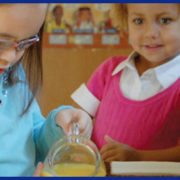By Erin McFarland
Math in the Montessori environment is one of the richest subject areas. Maria Montessori was a great mathematician and scientist. She became one of the first woman doctors in Italy. She used this scientific approach to study children and determine how to fashion materials that met their needs. She realized that in daily life, children naturally gravitated toward learning numbers. When they were taught numerals and quantities, they eagerly wanted to learn more. E.M. Standing quoted Maria in his book about her life as saying, “Children display a universal love of mathematics, which is par excellence the science of precision, order, and intelligence.” (Maria Montessori: Her Life and Work, p. 344)

Yasmine writing the numbers 1-50 down, after finishing the 50 board. (3 years old)
The whole Montessori classroom and how it is designed illustrates this concept beautifully. Every material has its place. Each work on the shelves is presented to the child in ordered steps, so that they can do it accurately. The materials are arranged on the shelves from easiest to most difficult. There is precision and order in the daily goings-on in the Montessori environment. Maria discovered that this environment put the child at ease and helped him to succeed.

Paloma using the stamp game to do 4-digit addition. (4 years old)
The math materials she created were carefully designed. The younger children in the classroom are introduced to complex ideas early and sensorially. One of the most famous Montessori materials is the Pink Tower, a stacking work of blocks that are arranged visually in descending order, from smallest to largest. Most children don’t realize until later that the Pink Tower is also a math work. The largest cube in the pink tower is 10 centimeters cubed, the next is 9 cm cubed, the next 8 cm cubed and so on. The Pink Tower is essentially a concrete example of the base 10 system, or an example of volume, or an opportunity to use incremental measurement in centimeters. The possibilities are endless. When young children have used a work like the Pink Tower, they internalize the visual differences and the tactile differences in size and weight. When they are older, they will be able to use this skill to judge differences perhaps much more quickly and accurately than children that did not use these materials. Instead of just knowing the answer, a child in a Montessori environment has touched and held and compared their answer to others. They can visualize the differences because they have held those numbers in their hands.
The Bead Cabinet is another example of Maria’s insightful design. It is visually beautiful; long strands of colored beads hang in perfect order longest to shortest. The small shelves in the cabinet match this order and contain beautifully colored beads arranged in lines of squares that end with a cube. The students use these beads to do skip counting, by 1’s, 2’s, 3’s, etc. They can see that 3 bead bars of 3 form a square that equals 9. When they stack three of these squares of 9 on top of each other (3 cubed) it forms a cube. They can see the numbers and how they are arranged. This is very practical for children that learn visually or tactilely. Number patterns and repetitions are easy to discover when the child can work hands-on. Maria Montessori said, “The hands are the instruments of man’s intelligence.” (Absorbent Mind, p. 25). She realized, long before educators of our time that by using one’s hands to do work, you are cementing this knowledge in your mind. Her math materials represent her devotion to this principle.











